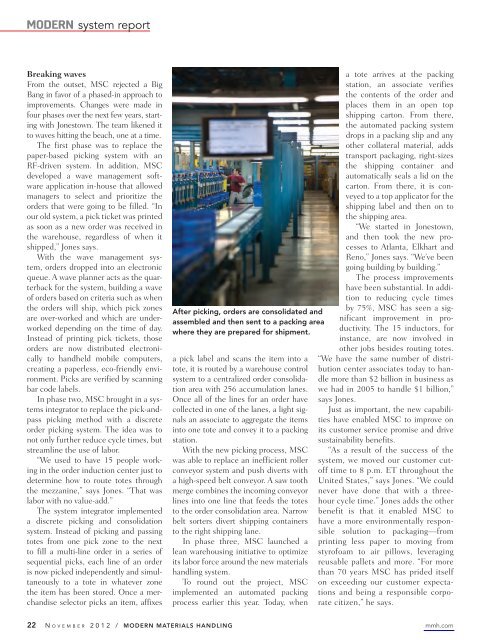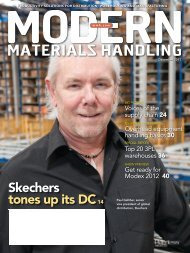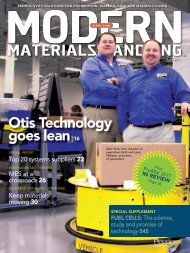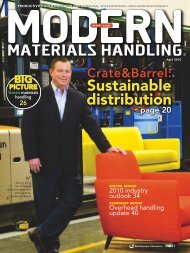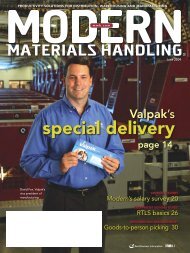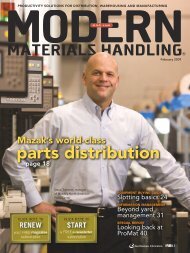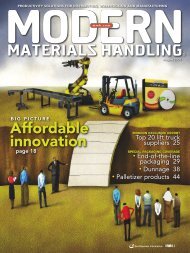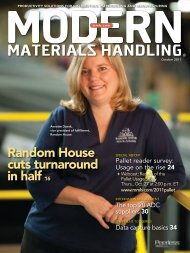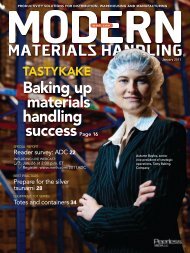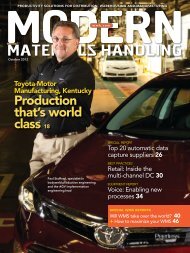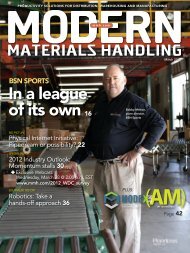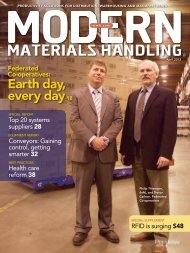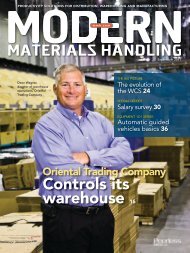Modern Materials Handling - November 2012
Modern Materials Handling - November 2012
Modern Materials Handling - November 2012
You also want an ePaper? Increase the reach of your titles
YUMPU automatically turns print PDFs into web optimized ePapers that Google loves.
modern system reportBreaking wavesFrom the outset, MSC rejected a BigBang in favor of a phased-in approach toimprovements. Changes were made infour phases over the next few years, startingwith Jonestown. The team likened itto waves hitting the beach, one at a time.The first phase was to replace thepaper-based picking system with anRF-driven system. In addition, MSCdeveloped a wave management softwareapplication in-house that allowedmanagers to select and prioritize theorders that were going to be filled. “Inour old system, a pick ticket was printedas soon as a new order was received inthe warehouse, regardless of when itshipped,” Jones says.With the wave management system,orders dropped into an electronicqueue. A wave planner acts as the quarterbackfor the system, building a waveof orders based on criteria such as whenthe orders will ship, which pick zonesare over-worked and which are underworkeddepending on the time of day.Instead of printing pick tickets, thoseorders are now distributed electronicallyto handheld mobile computers,creating a paperless, eco-friendly environment.Picks are verified by scanningbar code labels.In phase two, MSC brought in a systemsintegrator to replace the pick-andpasspicking method with a discreteorder picking system. The idea was tonot only further reduce cycle times, butstreamline the use of labor.“We used to have 15 people workingin the order induction center just todetermine how to route totes throughthe mezzanine,” says Jones. “That waslabor with no value-add.”The system integrator implementeda discrete picking and consolidationsystem. Instead of picking and passingtotes from one pick zone to the nextto fill a multi-line order in a series ofsequential picks, each line of an orderis now picked independently and simultaneouslyto a tote in whatever zonethe item has been stored. Once a merchandiseselector picks an item, affixesAfter picking, orders are consolidated andassembled and then sent to a packing areawhere they are prepared for shipment.a pick label and scans the item into atote, it is routed by a warehouse controlsystem to a centralized order consolidationarea with 256 accumulation lanes.Once all of the lines for an order havecollected in one of the lanes, a light signalsan associate to aggregate the itemsinto one tote and convey it to a packingstation.With the new picking process, MSCwas able to replace an inefficient rollerconveyor system and push diverts witha high-speed belt conveyor. A saw toothmerge combines the incoming conveyorlines into one line that feeds the totesto the order consolidation area. Narrowbelt sorters divert shipping containersto the right shipping lane.In phase three, MSC launched alean warehousing initiative to optimizeits labor force around the new materialshandling system.To round out the project, MSCimplemented an automated packingprocess earlier this year. Today, whena tote arrives at the packingstation, an associate verifiesthe contents of the order andplaces them in an open topshipping carton. From there,the automated packing systemdrops in a packing slip and anyother collateral material, addstransport packaging, right-sizesthe shipping container andautomatically seals a lid on thecarton. From there, it is conveyedto a top applicator for theshipping label and then on tothe shipping area.“We started in Jonestown,and then took the new processesto Atlanta, Elkhart andReno,” Jones says. “We’ve beengoing building by building.”The process improvementshave been substantial. In additionto reducing cycle timesby 75%, MSC has seen a significantimprovement in productivity.The 15 inductors, forinstance, are now involved inother jobs besides routing totes.“We have the same number of distributioncenter associates today to handlemore than $2 billion in business aswe had in 2005 to handle $1 billion,”says Jones.Just as important, the new capabilitieshave enabled MSC to improve onits customer service promise and drivesustainability benefits.“As a result of the success of thesystem, we moved our customer cutofftime to 8 p.m. ET throughout theUnited States,” says Jones. “We couldnever have done that with a threehourcycle time.” Jones adds the otherbenefit is that it enabled MSC tohave a more environmentally responsiblesolution to packaging—fromprinting less paper to moving fromstyrofoam to air pillows, leveragingreusable pallets and more. “For morethan 70 years MSC has prided itselfon exceeding our customer expectationsand being a responsible corporatecitizen,” he says.22 N o v e m b e r 2 0 1 2 / <strong>Modern</strong> <strong>Materials</strong> <strong>Handling</strong> mmh.com


